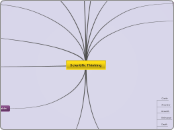Scientific Thinking
In Class
Learn to participate.
Getting to know everyone in class makes it:
Fun
Comfortable
Make new friends
Learn to present infront of class
Research Methods
Deductive method
Inductive method
Paradigm
Wrong Sciences
Pseudo science
Junk science
Bad science
Pathological science
Fallacies for Baloney detection
Ad hominem.
Argument from authority.
Argument from adverse consequences.
Appeal to ignorance
Special Pleading.
Begging the question.
Observational selection
Statistics of small number
Misunderstanding of the nature of statistics
Inconsistency
How to think critically:
Clarity
Acuuracy
Breadth
Relevance
Depth
Tools of Critical thinking
Skepticism
How to be skeptical:
Independent confirmation of facts
Knowledgable debate
More than 1 hypothesis
Do not get attached to your hypothesis
Ask if hypothesis is falsifiable
Separate variables.
Rationalism
Empiricism
No wishful or hopeful thinking
Science can be bad or good depending on how we use it.
Example of bad: Forging paintings
Example of good: Trying to discover forged paintings.
Example of good: Analysing whether photo was manipulated or not. (Dr. Hani Farid)
5 experimental techniques
Natural observation
Survey
Experimental
Correlation
Case study
Scientific Method
Observation.
Hypothesis.
Predict results.
Test.
Repeat.
Formulate a theory.
Different technologies
Use Mindomo.
Use Timelines.
How to use powerpoint.
Design Scientific Experiment
Make a Hypothesis.
Dependent variable
Independent Variable
Controlled variable
Control group, 100 people minumum.
Results
For hypothesis to be reliable:
Empirical
Measurable
Repeatable
Testable
Quantitative
Unbiased
